Lauki ki sabji recipe with step by step pics. Dudhi sabji or lauki sabzi is an easy and slightly spiced version of lauki sabzi. Lauki is also known bottle gourd or opo squash in english. In some other Indian languages lauki is known as ghiya, dudhi, sorakaya, sorakkai etc. It is one of the healthiest vegetables and is excellent to have during summer.
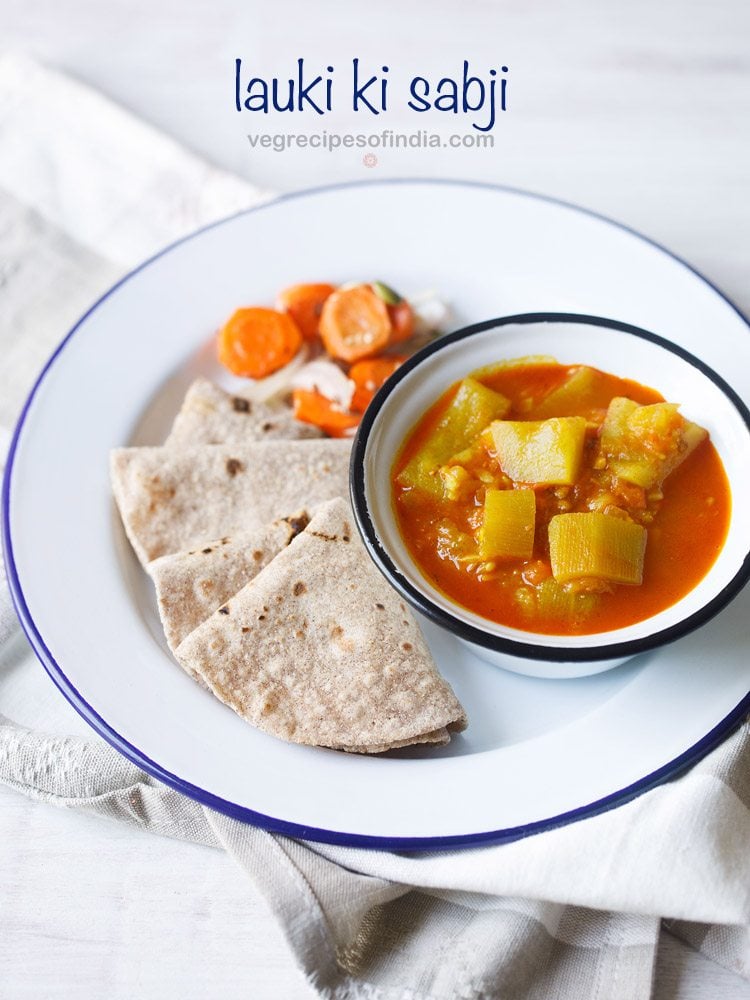
This lauki ki sabzi is a staple at home. This is a very homely recipe and is the like the food which we cook everyday. Making this lauki sabzi also does not take time and gets done quickly.
I learnt this Punjabi lauki recipe from my mother-in-law. Somehow I forgot to add the recipe. We usually make this sabzi slightly spicy as the spiciness goes well with the bland taste of lauki.
The recipe I have shared is not spicy. You can always add more green chilies, red chilly powder and garam masala powder for a spicy taste.
In addition to fresh lauki or bottle gourd, you would need onion, tomato, green chilies and ginger in this recipe. In spices, you would require cumin seeds, turmeric powder, red chili powder, coriander powder and asafoetida (hing). Although, the last 2 are optional and can be skipped too.
At time we also add dried lentil dumplings (Amritsari wadis or Punjabi wadis) in the sabzi. It really tastes fantastic and adds another texture element as well in the dish. If you have it, use it. You can also add some chana dal, if you wish to.
There is a tari or curry or gravy in the lauki sabzi. We do not make it dry. Dunking garma garam phulkas in the tangy gravy tastes so good. If you want you can add less water for less gravy.
The spice powders can also be added less or more depending on your preferences. The entire lauki sabzi has been cooked in a stovetop pressure cooker. You can also cook in a pan or pot adding water as required.
Craving more homestyle sabzis? Try the comforting Paneer Sabji, hearty Kathal Sabji, nutritious Palak ki Sabji, and lightly spiced Shimla Mirch ki Sabji.
How to make Lauki ki Sabji
1. Heat oil in a 2 litre stovetop pressure cooker. Add 1 teaspoon of cumin seeds. Keep the heat to low.
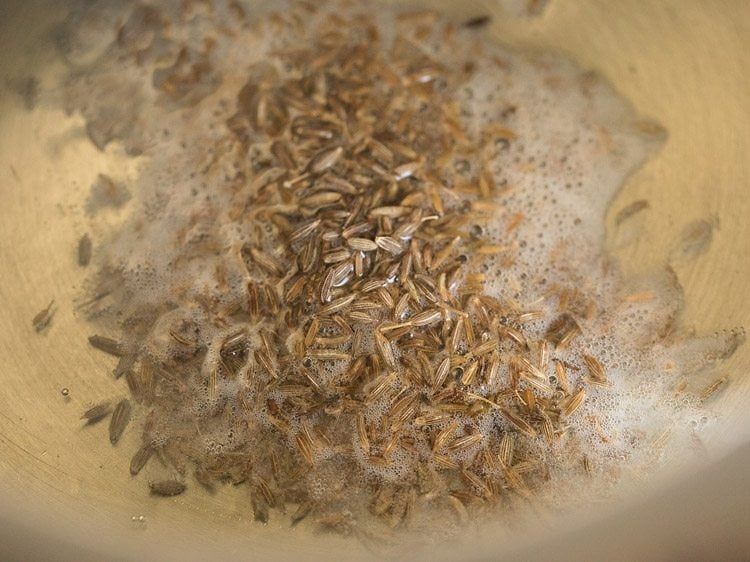
2. Let them splutter and crackle.

3. Then add ½ cup chopped onions.

4. Mix and begin to sauté onions on a medium-low heat.
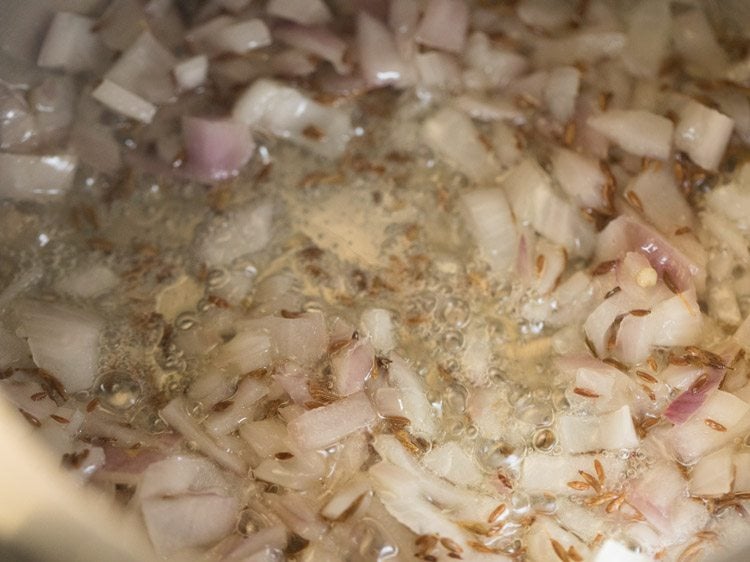
5. Sauté stirring often till onions turn translucent.
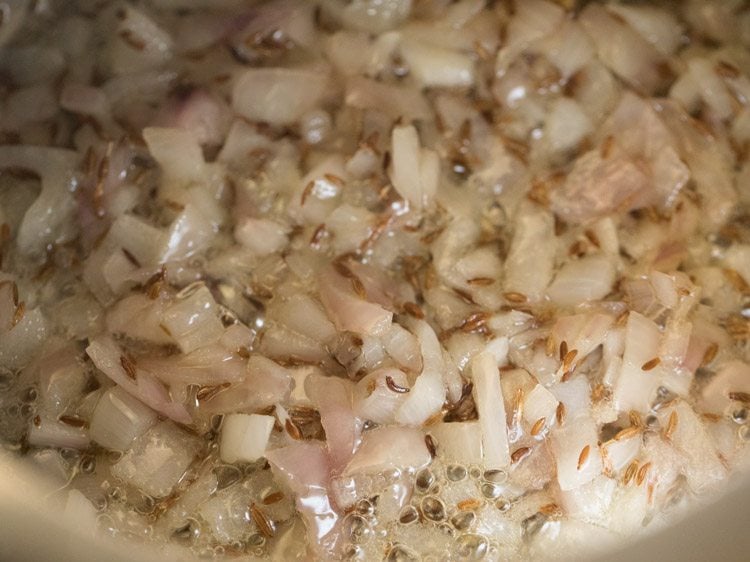
6. Now add 1 teaspoon of finely chopped ginger and 1 to 2 green chilies (chopped).
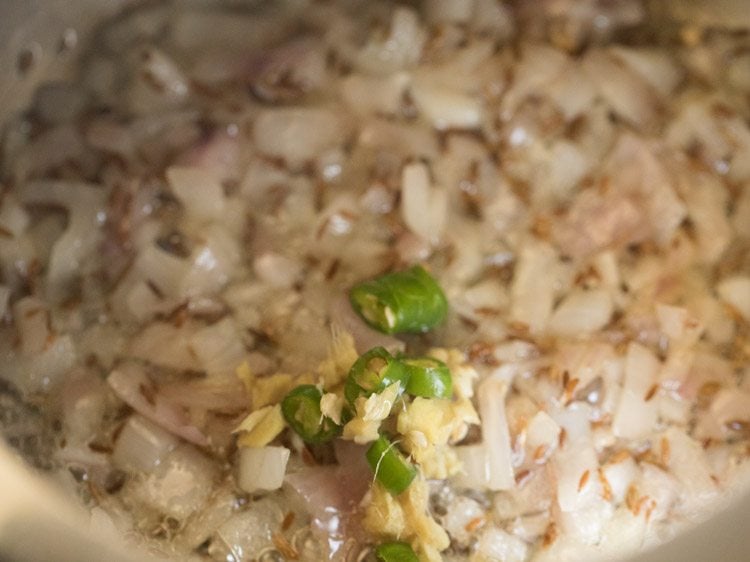
7. Sauté for some seconds or till the raw aroma of ginger goes away.

8. Then add 1 to 1.25 cups of tightly packed tomatoes.
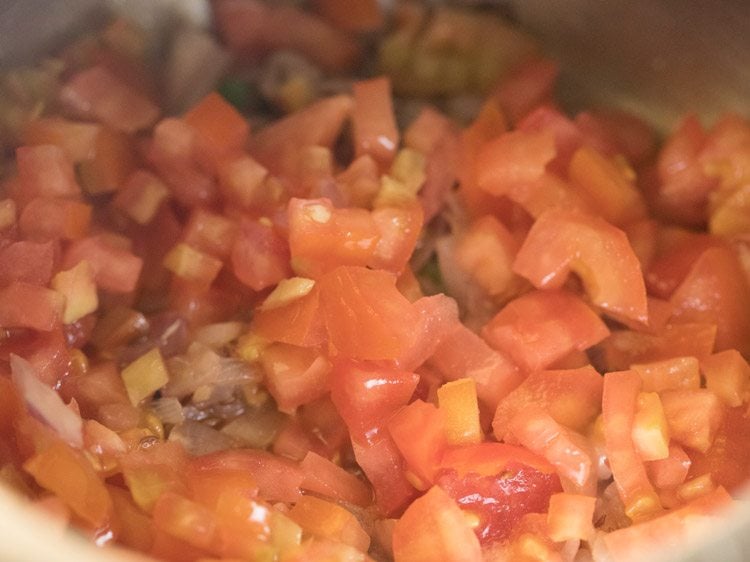
9. Mix and begin to sauté the tomatoes on a medium-low heat.

10. Sauté tomatoes till they become mushy and pulpy. The oil also starts to leave the masala. In the meantime when the tomatoes are getting cooked, rinse, peel and chop the lauki.

11. When the tomatoes have become pulpy and you see oil releasing from the sides of the masala, then add the following ground spices:
- ½ teaspoon turmeric powder
- ½ teaspoon Kashmiri red chili powder
- 1 teaspoon coriander powder (optional)
- Also add 1 pinch of asafoetida (optional)
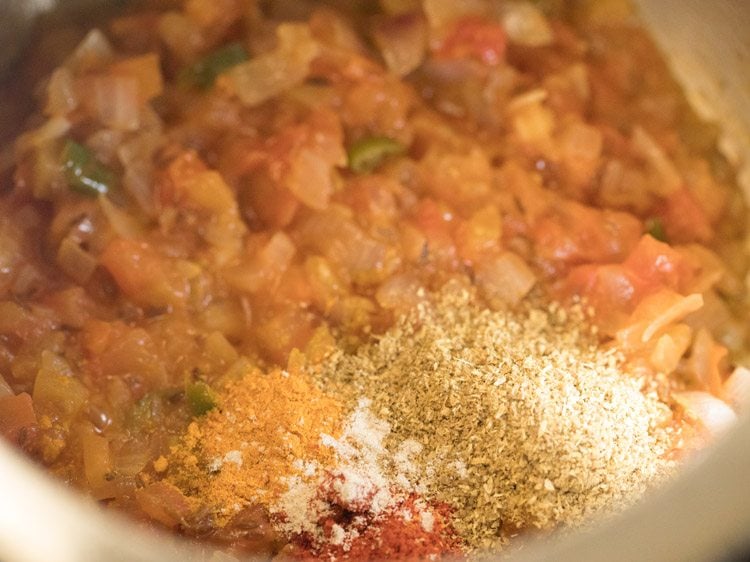
12. Stir and sauté for a minute.

13. Add 3 cups chopped lauki (bottle gourd or ghiya or dudhi).

14. Sauté for a minute.
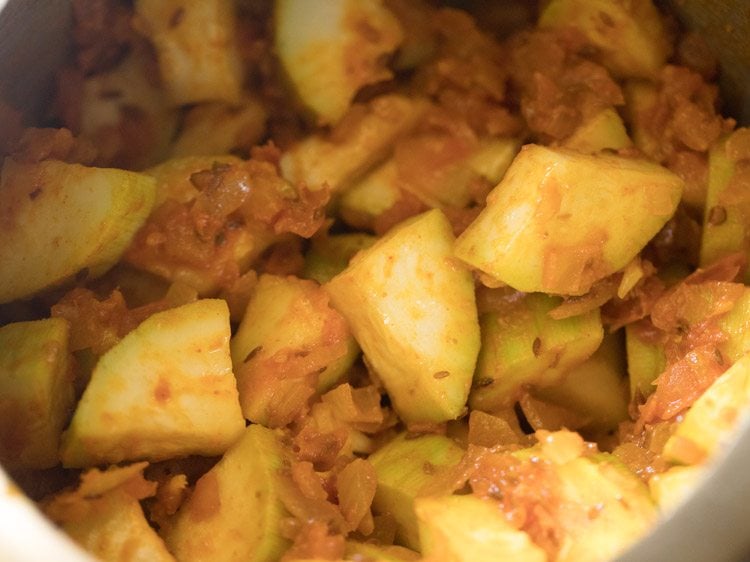
15. Add salt as per taste.
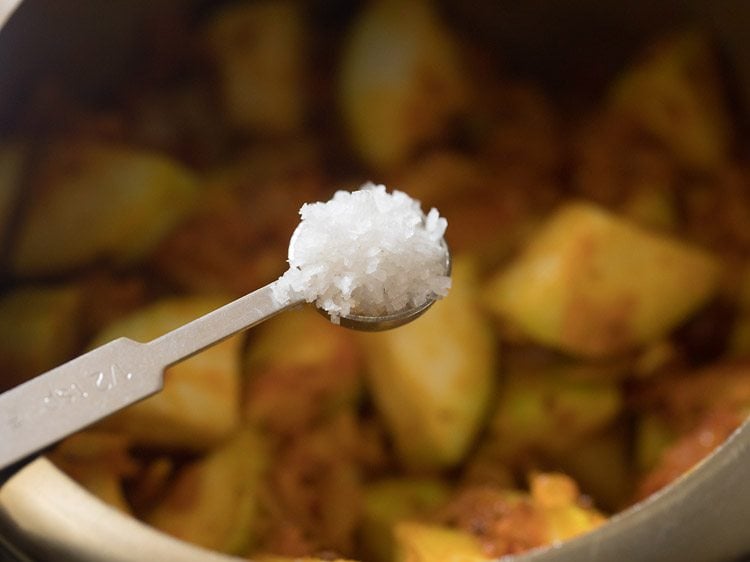
Cooking lauki sabji
16. Pour 1 cup of water.
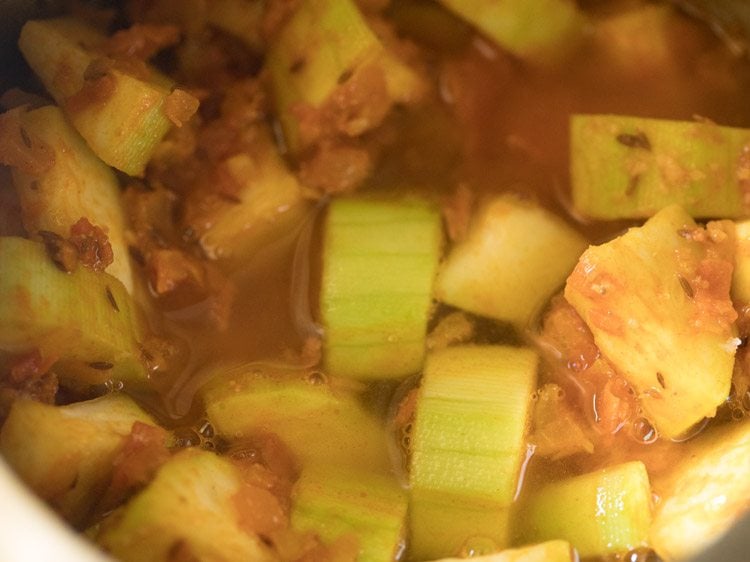
17. Stir and mix very well.
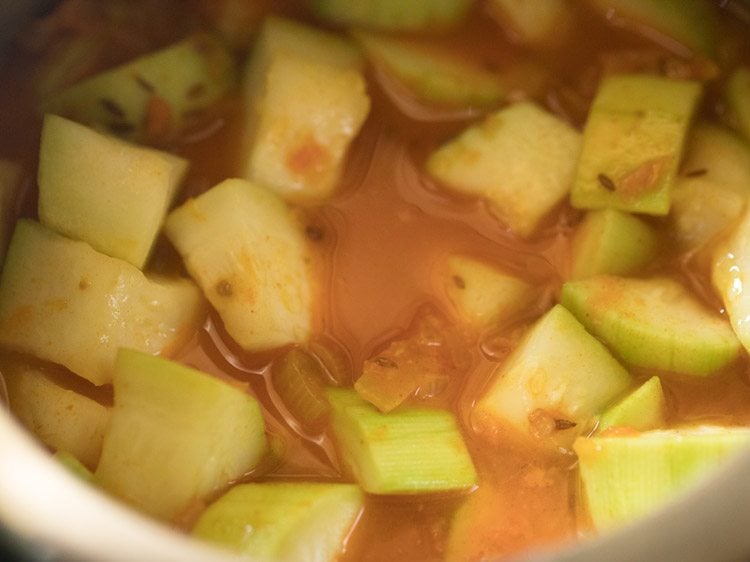
18. Pressure cook lauki sabzi for 3 to 4 whistles or 7 to 8 minutes on medium heat till the lauki is cooked well and becomes mushy.

19. When the pressure settles down on its own, then only open the lid of the cooker.

20. If you find the lauki sabzi to be more liquid then dry it a little by simmering in the cooker without the lid till you get the desired consistency in the sabzi.
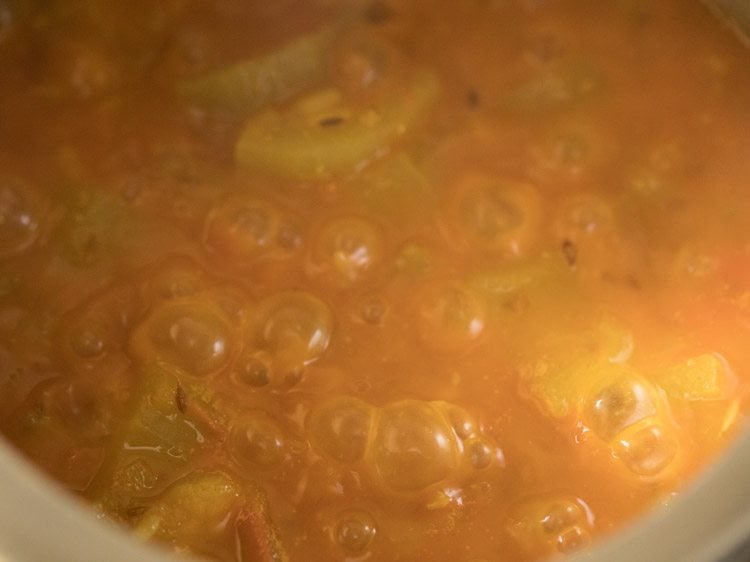
21. Finally add ½ teaspoon Punjabi garam masala powder or garam masala powder. You can also add 2 to 3 tablespoons of chopped coriander leaves at this step.

22. Stir and mix well.

23. Serve lauki ki sabzi hot or warm with some phulkas or chapatis or paratha.

Few more sabzi recipes for you!
If you’ve tried this recipe, please rate it in the recipe card or leave a comment below – I’d love to hear your feedback. For more vegetarian inspiration, sign up for my email updates or follow me on Instagram, Youtube, Facebook, Pinterest or X.

Lauki Sabji
Ingredients
- 2 tablespoons oil
- 1 teaspoon cumin seeds
- 1 medium size onion – finely chopped or ½ cup finely chopped onions
- 2 medium to large tomatoes – finely chopped or 1 to 1.25 cups tightly packed finely chopped tomatoes
- 1 or 2 green chilies – chopped
- 1 inch ginger – finely chopped or ground or 1 teaspoon finely chopped ginger
- ½ teaspoon turmeric powder
- ½ teaspoon Kashmiri Chilli Powder
- 1 teaspoon Coriander Powder – optional
- 1 pinch asafoetida (hing) – optional
- 3 cups chopped bottle gourd (lauki or ghiya or opo squash)
- 1 cup water for pressure cooking
- salt as required
- ½ teaspoon Punjabi Garam Masala or regular garam masala powder
- 2 to 3 tablespoons chopped coriander leaves (optional)
Instructions
- Heat oil in a 2 litre pressure cooker. Add 1 teaspoon cumin seeds.
- Let the cumin seeds splutter and crackle.
- Then add ½ cup chopped onions.
- Mix and begin to sauté onions on a medium-low flame till they turn translucent.
- Now add 1 teaspoon finely chopped ginger and 1 to 2 green chilies (chopped).
- Sauté for some seconds till the raw aroma of ginger goes away.
- Then add 1 to 1.25 cups tightly packed tomatoes.
- Mix and begin to sauté the tomatoes on a medium-low flame till they become mushy and pulpy. the oil also starts to leave the masala.
- In the meantime when the tomatoes are getting cooked, rinse, peel and chop the lauki. Keep aside.
- When the tomatoes have become pulpy and you see oil releasing from the sides of the masala, then add ½ teaspoon turmeric powder, ½ teaspoon red chili powder and 1 teaspoon coriander powder (optional). Also add 1 pinch of asafoetida (optional).
- Sauté for a minute.
- Then add 3 cups chopped lauki (bottle gourd or ghia). sauté for a minute.
cooking lauki sabji
- Add salt as per taste and pour 1 cup water. mix very well.
- Pressure cook lauki sabzi for 3 to 4 whistles or 7 to 8 minutes on medium flame till the lauki is cooked well and becomes mushy.
- When the pressure settles down on its own, open the lid of the cooker.
- If you find the lauki sabzi to be more liquid then dry it a little by simmering in the cooker without the lid till you get the desired consistency in the sabzi.
- Finally add ½ teaspoon punjabi garam masala powder or garam masala powder. You can also add 2 to 3 tablespoons chopped coriander leaves at this step.
- Mix well.
- Serve lauki ki sabzi hot with some phulkas or chapatis.
Nutrition Info (Approximate Values)
This Lauki ki Sabji post from the blog archives first published in May 2018 has been updated and republished on December 2022.


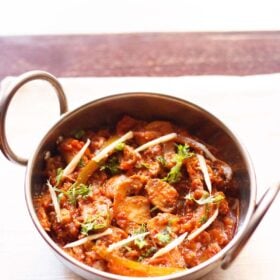
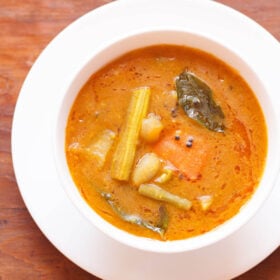








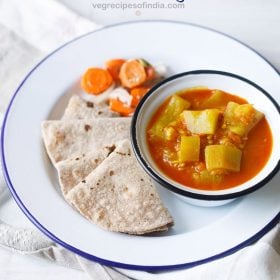
Tasty when used Punjabi garam masala
I didn’t have lauki so made with zucchini and came out so good with roti 😍
I think maybe this recipe would be great with other squash too, like the little yellow ones they sell at western grocery store.
When I can trek out to the Indian store in my area I’ll pick up lauki and make also. I will look up more sabzi recipes on your site, trying to be more healthy and have more vegetables these days 🥶
Yes, these work well with zucchini too. I think other squashes will work too. Yes do try more veggies and if possible let me know how the recipe went for you. Thanks Radha.
Hello, can you please tell me how to cook lauki ki sabzi faster in a pan. my today’s lauki ki sabzi didn’t cook quite soft in the pan.
the time taken to cook lauki depends on the quality of lauki. you can cover the pan with a lid and then cook them on low-medium to medium flame.
Nicely explained for a homely taste.
thanks rakesh.